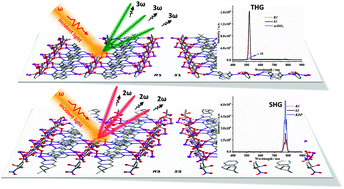Three pairs of homochiral Ag(I) enantiomers formulated as [Ag2(LR)(pa)]n/[Ag2(Ls)(pa)]n (R1/S1, H2pa = phthalic acid), [Ag2(LR)(tda)]n·H2O/[Ag2(Ls)(tda)]n·H2O (R2/S2, H2tda = 3,4-thiophene dicarboxylic acid), and [Ag4(LR)2(3-npa)2]n/[Ag4(Ls)2(3-npa)2]n (R3/S3, 3-H2npa = 3-nitrophthalic acid) were prepared by using different dicarboxylic acid coligands via the reactions of AgNO3 with enantiopure monobidentate N-donor heterocyclic ligands named (+)/(−)-4,5-pinenepyridyl-2-pyrazine (LS/LR), respectively. Investigations on the nonlinear optical (NLO) response suggest R1/S1 and R2/S2 enantiomers present very strong third-harmonic generation (THG) responses, and the lowest THG intensities of R1/S1 and R2/S2 are 244 and 142 times that of α-SiO2, respectively. However, R3/S3 enantiomers only exhibit mild second-harmonic generation (SHG) response (0.36 × KDP). A comparative study on the molecular structures of these Ag(I) enantiomeric pairs reveals that both the symmetry and degree of π-conjugation of the dicarboxylate ligands are mainly responsible for their different NLO responses. Our research result not only provides a feasible method of constructing coordination polymers (CPs) with strong THG response but also points out an effective strategy for switching NLO behaviors from THG to SHG response.
